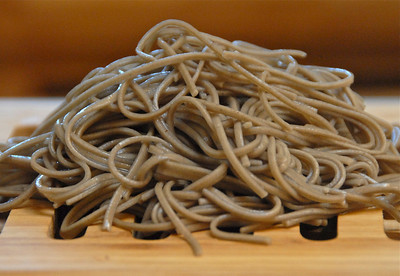
Last week I owned up to my obsession with and quest for great soba in Japan. Prior to this trip, I’d been satisfied with dried soba from the Asian section of Fairway Market. Now, however, I’m like those Italian food snobs who shun anything but handmade pastas. I want my noodles fresh and unprocessed. I want my noodles made by hand.
With a copy of Takashi Yagihashi’s Takashi’s Noodles spread out on my kitchen counter I set out to create soba. Yagihashi’s clear directions and illustrative, color photographs made it seem easy. After all, the recipe only required three ingredients and a bit of kneading. How hard could it be?
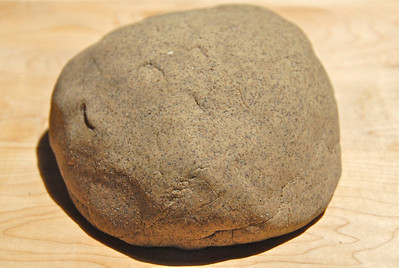
I quickly realized that, as with pasta, soba making is an art that I wouldn’t master on the first or second try. Ingredients were one obstacle. Buckwheat flour is not as elastic as other flours; it doesn’t contain gluten, a necessary component for stretchiness. To compensate for this absence, cooks often use a ratio of 20% gluten-rich whole wheat flour and 80% buckwheat flour in their soba.
Following Yagihashi’s recipe, I added 1/3 cup, less than 20%, all-purpose flour; this flour has a slightly lower gluten content than whole wheat. The resulting dough was more crumbly than stretchy. I later switched to whole wheat flour and bumped up the amount to 7 generous tablespoons, making the dough a tad more pliant than the original.
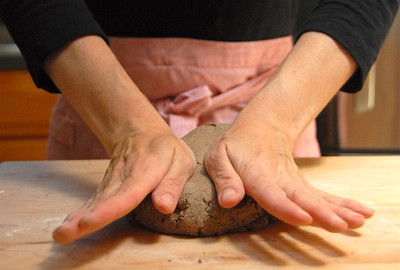
Knowing how long to knead was another hurdle. Initially I didn’t do it long or vigorously enough. As a result, when I rolled out the dough, it tore. Accepting that I’m not the strongest of kneaders, I substituted my stand mixer’s sturdy dough hook for my wimpy arms. I then ended up with springy dough that slid back into shape with each roll of the pin. Frustrated, I returned to hand kneading and just worked beyond the suggested 5 to 6 minutes. If you, too, suffer from scrawniness, knead your dough for 8 to 10 minutes. It will be smooth, shiny and fairly elastic when done.
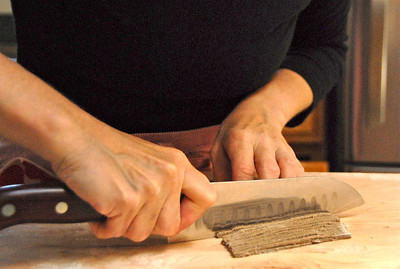
In Japan soba is cut with a flat, 12″ long and 6″ wide knife known as a soba kiri. In my kitchen it’s sliced with a Santoku knife. If you own a sharp, Japanese knife, you might as well use it on this Japanese specialty. Otherwise, any long, flat-bladed knife should work. I suspect that even a bench scraper would do the trick.
Fragrant noodles cut and impediments overcome, the last step was to boil the soba for 30 to 60 seconds in unsalted water. Once they’d finished cooking, I plunged them into ice water to cool. After that I drained, dried and ate the soft, nutty noodles with a smidgen of soy sauce and sesame oil. Easy to make? Not yet. More delectable than dried? Absolutely!
BASIC SOBA
Adapted from Takashi Yagihashi’s Takashi’s Noodles (Ten Speed Press, 2009)
2 1/4 cups buckwheat flour (available online from shops such as Kalustyan’s)
7 tablespoons whole wheat flour
1 cup water, at room temperature, plus more as needed
Sift the flours together in a large bowl. Add the water and mix the ingredients together by hand. If the dough seems too dry, add more water in small increments. You want the mixture to be firm and smooth, like pasta dough, but not crumbly.
Form the dough into a mound and place it on a lightly floured work surface. Knead by folding the dough over once and pressing downward and forward with your hands. Turn the dough one-quarter clockwise and continue kneading and turning for 5 to 10 minutes, until the dough becomes smooth, shiny and stretches when pulled. Cover the dough with cling wrap and allow it to rest for 20 minutes at room temperature.
After 20 minutes unwrap the dough and divide it in half. Cover one piece and place the other on a lightly floured work surface. Using a flour-dusted rolling pin, roll out the dough until it becomes a rectangle 18 inches long and 1/16-inch thick.
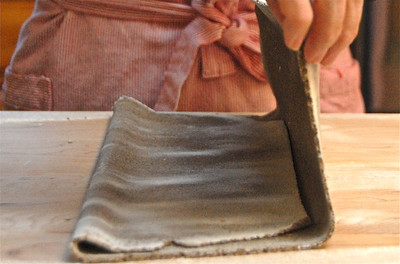
Fold the dough into thirds. Using a flat, sharp knife and a lightweight box or board as your guide, slice the folded dough into 1/8-inch thick noodles. Shake out the cut noodles and set them aside until ready to cook. Roll out and cut the second piece of dough.
At this point you’re ready to cook your noodles. For recipes see the entries Searching for Soba and Southeast Asian Soiree.